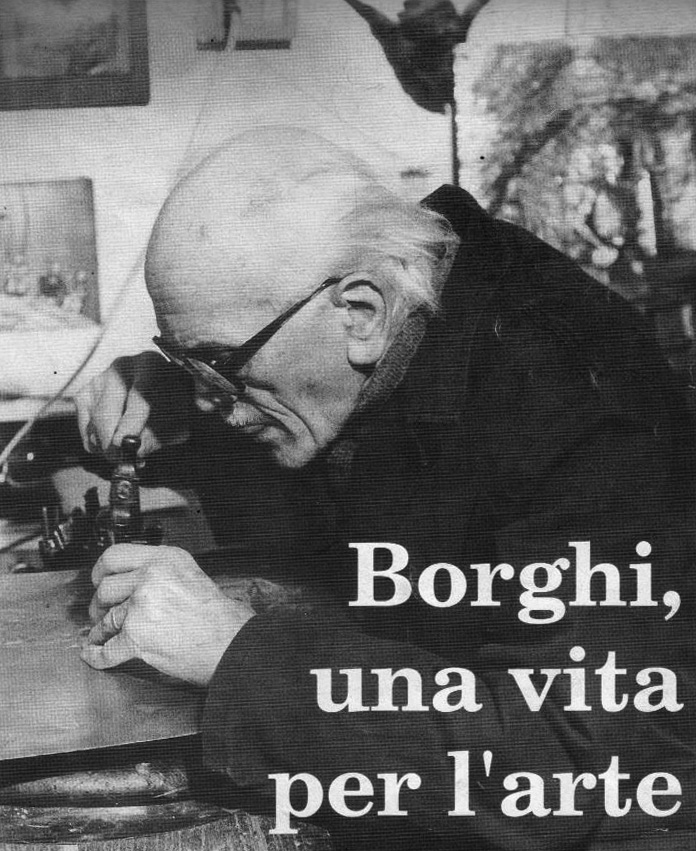Stanislao Borghi Silversmiths

Our Story
Stanislao Borghi (1898-1998), considered one of the most prestigious artists in the technique of silver chasing, opened his artisan workshop in Malnate, in the province of Varese in 1929.As early as 1925, Borghi was regarded as an exceptional artist, so much that acclaimed silversmiths from Milan commissioned him to create an artwork for King Victor Emanuele III on the occasion of the International Trade Fair of the same year.
The young artist designed and created a large ornamental centrepiece with an embossed portrait of the King in the centre and depictions of heroic feats of the Great War all around him.
His definitive success was confirmed in 1926, when he was entrusted with making a copy of the highly celebrated silver shield crafted by Benvenuto Cellini, which is now held in the Royal Armoury of Turin.
In the same period the artist was also charged by the Italian Director of Archaeological Studies, Engineer Antonio Giussani, with replicating the acclaimed Gravedona Cross, a precious work dated 1508, which had been stolen and destroyed in 1920.
When Borghi’s five adult children began working in the workshop in Malnate, after having specialised in goldsmithing, silversmithing, sculpture and precious metal chasing, the master’s works were often designed with the contribution of one or more of them.
With his son Paolo, now an internationally renowned sculptor, Borghi created the silver and gold votive lamp for the Aedicule of the Church of the Holy Sepulchre in Jerusalem. His career in the field of art, especially sacred art, grew rapidly and flourished. He produced works regarded as true masterpieces: monstrances, chalices, tabernacles, stations of the cross, as well as other unique chased works for religious institutions all over Italy and the world.
With his son Paolo, now an internationally renowned sculptor, Borghi created the silver and gold votive lamp for the Aedicule of the Church of the Holy Sepulchre in Jerusalem. His career in the field of art, especially sacred art, grew rapidly and flourished. He produced works regarded as true masterpieces: monstrances, chalices, tabernacles, stations of the cross, as well as other unique chased works for religious institutions all over Italy and the world.
An important collaboration between Borghi and the sculptor Floriano Bodini produced masterworks for the Basilica of the Holy House in Loreto, Italy, for the Vatican during the pontificate of Pope John Paul III, and for the church dedicated to Padre Pio of Pietrelcina, designed by Renzo Piano.
In the workshop of Borghi’s sons Giovanni and Francesco, several plaster casts used by their father are on display; one cast used for months by Borghi, when copying Cellini’s shield, was lost for many years and was later rediscovered at the Cusi Palace gallery in Milan.
In the workshop of Borghi’s sons Giovanni and Francesco, several plaster casts used by their father are on display; one cast used for months by Borghi, when copying Cellini’s shield, was lost for many years and was later rediscovered at the Cusi Palace gallery in Milan.
The artistic mastery of the father was passed down to his sons, among them, Paolo, who is a sculptor, Giovanni, a silver chaser, Francesco, who is an expert goldsmith, and Luigi, who creates fine works in silver in the Como workshop.
The skills and expertise of the Borghi Brothers, acquired by years of contact with their father’s techniques and experience, are clearly demonstrated in their works – and in those which they carry out according to a client’s design.
Artistic talent was also passed down to the following generation; grandsons Matteo and Pietro have taken a more modern approach to the art they inherited from their grandfather, reorienting it towards contemporary design.
The skills and expertise of the Borghi Brothers, acquired by years of contact with their father’s techniques and experience, are clearly demonstrated in their works – and in those which they carry out according to a client’s design.
Artistic talent was also passed down to the following generation; grandsons Matteo and Pietro have taken a more modern approach to the art they inherited from their grandfather, reorienting it towards contemporary design.








